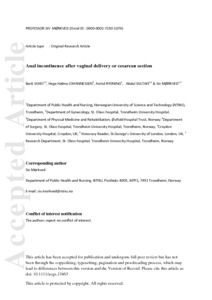Schei, B; Johannessen, HH; Rydning, A; Sultan, A; Mørkved, S
(2018)
Anal incontinence after vaginal delivery or cesarean section.
Acta Obstet Gynecol Scand, 98 (1).
pp. 51-60.
ISSN 1600-0412
https://doi.org/10.1111/aogs.13463
SGUL Authors: Sultan, Abdul Hameed
![[img]](https://openaccess.sgul.ac.uk/110265/1.hassmallThumbnailVersion/Schei_et_al-2018-Acta_Obstetricia_et_Gynecologica_Scandinavica.pdf)  Preview |
|
PDF
Accepted Version
Available under License ["licenses_description_publisher" not defined].
Download (906kB)
| Preview
|
Abstract
INTRODUCTION: Uncertainties remain as to whether cesarean section is protective for short and long term development of anal incontinence. Our aim was to explore whether women who had only delivered vaginally were at greater risk of anal incontinence compared to nulliparous women and women who had undergone caesarean sections only. MATERIAL AND METHODS: Background information, medical history and data on anal incontinence (defined as fecal or flatus incontinence weekly or more) reported by women participating in a large population-based health survey in Norway (HUNT 3) during the period October 2006-June 2008, was collected and linked to data from the Medical Birth Registry of Norway. Anal incontinence prevalence was calculated and multivariable logistic regression analyses were applied. RESULTS: Mean age amongst the 12.567 women was 49.9 years. Age and educational level were similar in women with caesarean sections only and those with vaginal delivery and obstetric anal sphincter injuries (OASIS). Nulliparas and women with vaginal delivery and no OASIS were older and had higher educational achievements. One in four women with OASIS reported anal incontinence compared to one in six amongst the other women(p<.001). Age, educational level, diarrhea, constipation, birthweight and OASIS increased the risk of anal incontinence in all women. Parity was associated with anal incontinence in parous women only. No differences were found for fecal urgency. CONCLUSIONS: Women with vaginal deliveries complicated by OASIS were at increased risk of anal incontinence. However, no increased risk of anal incontinence was found in nulliparous women or women with cesarean sections only or vaginal deliveries not complicated by OASIS.
| Item Type: |
Article
|
| Additional Information: |
This is the peer reviewed version of the following article: Schei B, Johannessen HH, Rydning A, Sultan A, Mørkved S. Anal incontinence after vaginal delivery or cesarean section. Acta Obstet Gynecol Scand. 2019;98:51–60, which has been published in final form at https://doi.org/10.1111/aogs.13463. This article may be used for non-commercial purposes in accordance with Wiley Terms and Conditions for Use of Self-Archived Versions. |
| Keywords: |
Anal incontinence, HUNT - study, Norway, cesarean section, population based study, vaginal delivery, 1114 Paediatrics And Reproductive Medicine, 1117 Public Health And Health Services, Obstetrics & Reproductive Medicine |
| SGUL Research Institute / Research Centre: |
Academic Structure > Institute of Medical & Biomedical Education (IMBE) |
| Journal or Publication Title: |
Acta Obstet Gynecol Scand |
| ISSN: |
1600-0412 |
| Language: |
eng |
| Dates: |
| Date | Event |
|---|
| 18 December 2018 | Published | | 29 October 2018 | Published Online | | 17 August 2018 | Accepted |
|
| Publisher License: |
Publisher's own licence |
| PubMed ID: |
30204238 |
 |
Go to PubMed abstract |
| URI: |
https://openaccess.sgul.ac.uk/id/eprint/110265 |
| Publisher's version: |
https://doi.org/10.1111/aogs.13463 |
Statistics
Item downloaded times since 17 Oct 2018.
Actions (login required)
 |
Edit Item |



